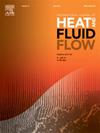管型和流道对螺旋槽套管内超临界CO2冷却换热特性的影响研究
IF 2.6
3区 工程技术
Q2 ENGINEERING, MECHANICAL
International Journal of Heat and Fluid Flow
Pub Date : 2025-03-04
DOI:10.1016/j.ijheatfluidflow.2025.109804
引用次数: 0
摘要
本文研究了超临界CO2 (SCO2)在5种不同螺旋槽套管中的换热特性,并提出了一种综合评价因子来评价其整体性能,旨在通过优化套管设计来提高换热器效率。采用有限体积法对三启圆弧(A)、四启圆弧(B)、四启梯形(C)、四启三角形(D)和六启圆弧(E)五种不同的螺旋槽形态进行了模拟和比较。结果表明,当SCO2通过内外管之间的通道(通道1)时,工况E的换热系数最高,为2537.91 W·(m2·K)−1;这明显高于其他设计,最大增幅为19.20%,证明了其在提高换热效率方面的最佳性能。在内管通道(通道2)中,情况D和情况E的平均换热系数大致相等,约为2410 W·(m2·K)−1,比其他三种设计的平均换热系数高3.22%,表明通道2的槽形优化潜力巨大。SCO2在通道2内的流动方式可以有效降低压降梯度,最大降幅为27.60%,从而显著提高了系统的安全性。案例A通道2的SCO2流动模式综合评价因子值(2.03)最优。这些科学发现为SCO2换热器的优化设计提供了有益的见解。本文章由计算机程序翻译,如有差异,请以英文原文为准。

Study on the influence of tube type and fluid flow channel on cooling heat transfer characteristics of supercritical CO2 in spirally grooved casing tubes
This study investigates the heat transfer characteristics of supercritical CO2 (SCO2) in five different spirally grooved casing tubes and proposes a comprehensive evaluation factor to assess their overall performance, aiming to improve heat exchanger efficiency through optimizing tube designs. The Finite Volume Method is employed to simulate and compare five different spirally grooved configurations: three-start circular arc (Case A), four-start circular arc (Case B), four-start trapezoidal (Case C), four-start triangular (Case D), and six-start circular arc (Case E). The results show that when SCO2 flows through the channel between the inner and outer tubes (channel 1), Case E exhibits the highest heat transfer coefficient, with a value of 2537.91 W·(m2·K)−1. This is significantly higher than the other designs, with a maximum increase of 19.20 %, demonstrating its optimal performance in enhancing heat transfer efficiency. In the inner tube channel (channel 2), the average heat transfer coefficients for Case D and Case E are approximately equal, around 2410 W·(m2·K)−1, which is 3.22 % higher on average than the other three designs, indicating impressive potential for optimizing the groove shape in channel 2. The pattern of SCO2 flowing in channel 2 can effectively reduce the pressure drop gradient, with a maximum reduction of 27.60 %, thereby significantly improving the safety of the system. The flow pattern of SCO2 in channel 2 of Case A exhibits the optimal comprehensive evaluation factor value (2.03). These scientific findings provide conducive insights for optimizing design of the SCO2 heat exchangers.
求助全文
通过发布文献求助,成功后即可免费获取论文全文。
去求助
来源期刊

International Journal of Heat and Fluid Flow
工程技术-工程:机械
CiteScore
5.00
自引率
7.70%
发文量
131
审稿时长
33 days
期刊介绍:
The International Journal of Heat and Fluid Flow welcomes high-quality original contributions on experimental, computational, and physical aspects of convective heat transfer and fluid dynamics relevant to engineering or the environment, including multiphase and microscale flows.
Papers reporting the application of these disciplines to design and development, with emphasis on new technological fields, are also welcomed. Some of these new fields include microscale electronic and mechanical systems; medical and biological systems; and thermal and flow control in both the internal and external environment.
 求助内容:
求助内容: 应助结果提醒方式:
应助结果提醒方式:


